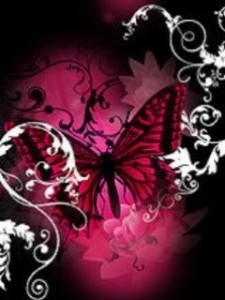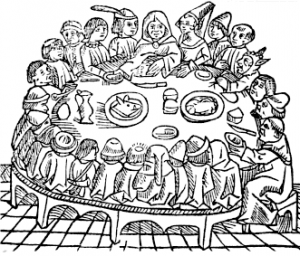I know I mentioned several months ago when I first started my Chaucer Project that I would list my works cited (consulted/influenced by/on the same topic, etc.) at the end, but I honestly didn’t realize the size this project would take. Since I do not foresee myself finishing it in the near future and a few of you asked, here is my more or less working bibliography.
I will edit this periodically as the project continues (while I stare at the vast sea of post-it notes with titles and authors hurriedly jotted down). When I eventually do something more with the project as a whole, all the references will be placed accordingly. Yes, I have notes as to where everything goes, but in blog format it would have just appeared entirely too cluttered. Also, this list is incomplete for a secondary reason – my sources are currently split up between my office, my living room, and my car. As I begin consolidating them, the list will grow.
These works are currently not in any decipherable order, nor formal format.
(I am not listing the manuscripts, as all access to them is in digitized format available from the various institutions that house them).
Benson, David C. Chaucer’s Drama of Style: Poetic Variety and Contrast in The Canterbury Tales.
Dempster, Germaine. “The Fifteenth-Century Editors of The Canterbury Tales and the Problem of Tale Order.”
Seymour, M.C. “Hypothesis, Hyperbole, and the Hengwrt Manuscript of the Canterbury Tales.”
Hanna, Ralph. Ellesmere Manuscript of Chaucer’s Canterbury Tales: A Working Facsimile.
Owen, Charles A. The Manuscript of the Canterbury Tales.
Doyle, A. I. and M. B. Parkes. “A Paleographical Introduction.”
Mandel, Jerome. Building the Fragments of the Canterbury Tales.
Lerer, Seth. Chaucer and His Readers: Imagining the Author in Late Medieval England.
Ramsey, Roy Vance. The Manly and Rickert Text of the Canterbury Tales.
Dempster, Germaine. “On the Significance of Hengwrt’s Change of Ink in the Merchant’s Tale.”
Blake, N.F. “The Ellesmere Text In Light of the Hengwrt Manuscript.”
Cooper, Helen. “The Order of the Tales in the Ellesmere Manuscript.”
Doyle, A. I. “The Copyist of the Ellesmere Canterbury Tales.”
Hanna, Ralph. “(The) Editing (of) the Ellesmere Text.”
Parkes, M. B. “The Planning and Construction of the Ellesmere Manuscript.”
Smith, Jeremy J. “The Language of the Ellesmere Manuscript.”
Boffey, Julia. “Proverbial Chaucer and the Chaucer Canon.”
Howard, Donald R. “Where Did Chaucer Get His Idea For The Canterbury Tales?”
Windeatt, B. A. “The Scribes as Chaucer’s Early Critics.”
Condren, Edward I. Chaucer and the Energy of Creation.
Schulz, Herbert. The Ellesmere Manuscript of Chaucer’s Canterbury Tales.
Powell, Stephen. “Game Over: Defragmenting the End of The Canterbury Tales.”
Morse, Charlotte C. “Popularizing Chaucer in the Nineteenth Century.”
Spencer, Matthew. et al. “Analyzing the Order of Items in Manuscripts of The Canterbury Tales.”
Edwards, A. S. G. “A New Text of The Canterbury Tales?”
Purdie, Rhiannon. “The Implications of Manuscript Layout in Chaucer’s Tale of Sir Thopas.”
Mininis, Alastair. Medieval Theories of Authorship: Scholastic Literary Attitudes in the Later Middle Ages.
Edwards, A. S. G. “The Ellesmere Manuscript: Controversy, Culture, and The Canterbury Tales.”
Horobin, Simon. “Adam Pinkhurst, Geoffrey Chaucer, and the Hengwrt Manuscript of The Canterbury Tales.”
Orietta, Da Rold. “Manuscript Production Before Chaucer: Some Preliminary Observations.”
Bradshaw, Henry. The Skeleton of Chaucer’s Canterbury Tales.
Tatlock, John S. P. “Boccaccio and the Plan of Chaucer’s Canterbury Tales.”
Brusendorff, Aage. The Chaucer Tradition.
McCormick, Sir William, and Janet E. Heseltine. The Manuscripts of Chaucer’s Canterbury Tales: A Critical Description of Their Contents.
Tatlock, John S. P. “The Canterbury Tales in 1400.”
Manly, John Matthews, and Edith M. Rickert, eds. The Text of the Canterbury Tales, Studied on the Basis of all Known Manuscripts. 8 Vols.
Root, Robert K. “The Text of The Canterbury Tales.”
Dempster, Germaine. “Manly’s Conception of The Canterbury Tales.”
Pratt, Robert. “The Order of The Canterbury Tales.”
Stevens, J. Burke. “Did Chaucer Rearrange the Clerk’s Envoy?”
Baldwin, Ralph. The Unity of The Canterbury Tales.
Luminiasky, R. M. Of Sondry Folk: The Dramatic Principle in the Canterbury Tales.
Pratt, Robert and Karl Young. “The Literary Framework of The Canterbury Tales.”
Clawson, William H. “The Framework of The Canterbury Tales.”
Owen, Charles A. “The Earliest Plan of The Canterbury Tales.”
McCall, John P. “Chaucers May 3.”
Grennen, Joseph E. “Saint Cecilia’s ‘Chemical Wedding:’ the Unity of The Canterbury Tales, Fragment VIII.”
Berger, Harry. “The F-Fragment of The Canterbury Tales.”
Gardfgvner, John. “The Case Against the Bradshaw Shift; or, The Mystery of the Manuscript in the Trunk.”
Whittock, Trevor. A Reading of The Canterbury Tales.
Donaldson, E. Talbot. “The Ordering of the Canterbury Tales.”
Howard, Donald R. “The Canterbury Tales: Memory and Form.”
Fisher, John H. “Chaucer’s Last Revision of The Canterbury Tales.”
Kean, P.M. Chaucer and the making of English Poetry: The Art of Narrative. Vol. 2.
Donaldson, Talbot E. “The Manuscripts of Chaucer’s Works and Their Use.”
Doyle, A. I. “The Production of The Canterbury Tales and the Confessio Amantis in the Early Fifteenth Century.”
Lawrence, William W. Chaucer and The Canterbury Tales.
Allen, Judson Boyce, and Theresa Anne Moritz. A Distinction of Stories: The Medieval Unity of Chaucer’s Fair Chain of Narratives for Canterbury.
Blake, N. F. “Critics, Criticism and the Order of The Canterbury Tales.”
Cooper, Helen. The Structure of The Canterbury Tales.
Traversi, Derek. The Canterbury Tales: A Reading.
Kane, George. “John M. Manly and Edith Rickert.”
Dean, James. “Dismantling the Canterbury Book.”

